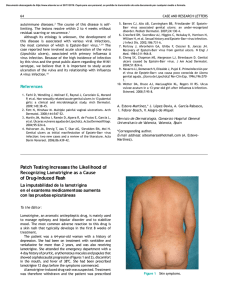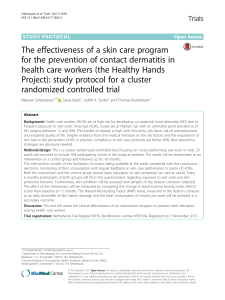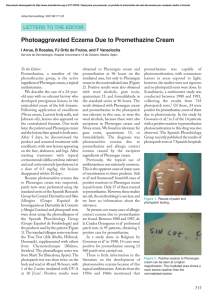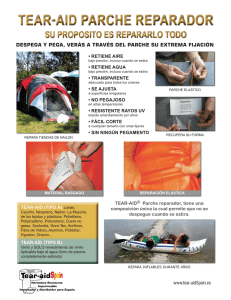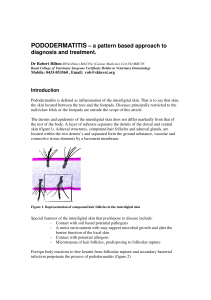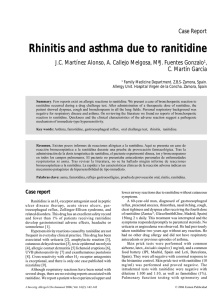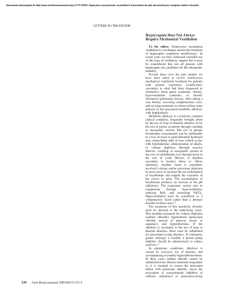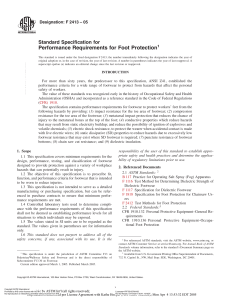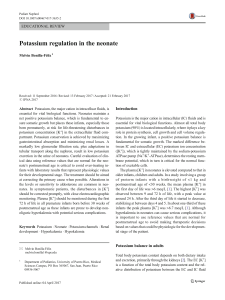Allergic Contact Dermatitis to Footwear in Children
Anuncio
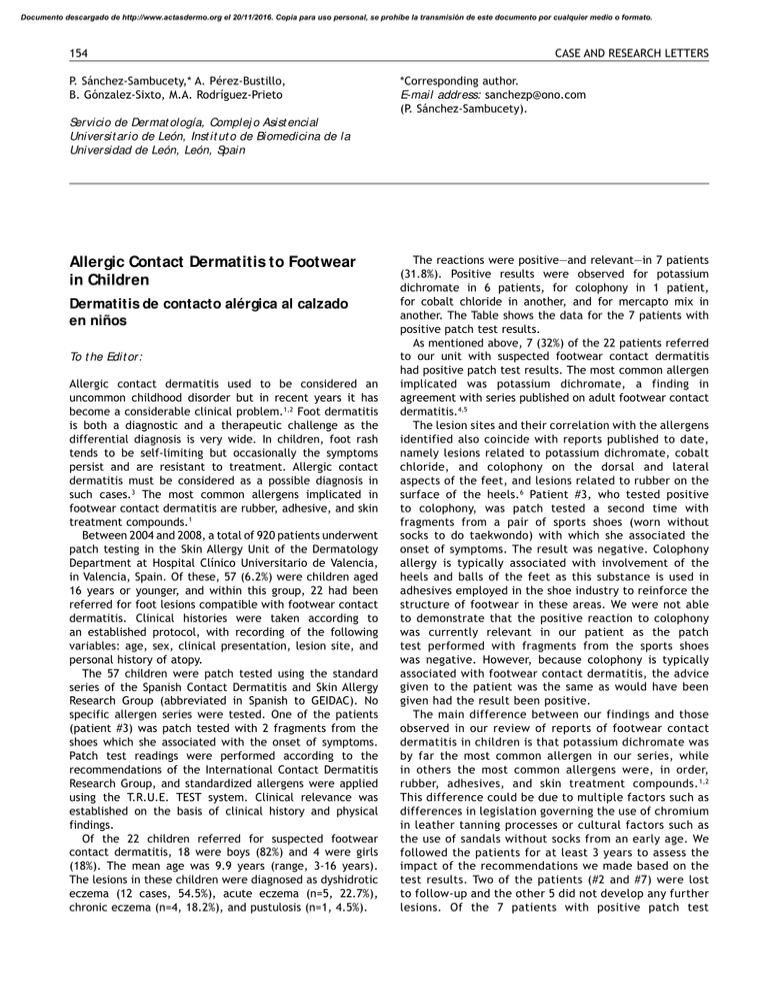
Documento descargado de http://www.actasdermo.org el 20/11/2016. Copia para uso personal, se prohíbe la transmisión de este documento por cualquier medio o formato. 154 P. Sánchez-Sambucety,* A. Pérez-Bustillo, B. Gónzalez-Sixto, M.A. Rodríguez-Prieto CASE AND RESEARCH LETTERS *Corresponding author. E-mail address: [email protected] (P. Sánchez-Sambucety). Servicio de Dermat ología, Complej o Asist encial Universit ario de León, Inst it ut o de Biomedicina de la Universidad de León, León, Spain Allergic Contact Dermatitis to Footwear in Children Dermatitis de contacto alérgica al calzado en niños To t he Edit or: Allergic contact dermatitis used to be considered an uncommon childhood disorder but in recent years it has become a considerable clinical problem.1,2 Foot dermatitis is both a diagnostic and a therapeutic challenge as the differential diagnosis is very wide. In children, foot rash tends to be self-limiting but occasionally the symptoms persist and are resistant to treatment. Allergic contact dermatitis must be considered as a possible diagnosis in such cases.3 The most common allergens implicated in footwear contact dermatitis are rubber, adhesive, and skin treatment compounds.1 Between 2004 and 2008, a total of 920 patients underwent patch testing in the Skin Allergy Unit of the Dermatology Department at Hospital Clínico Universitario de Valencia, in Valencia, Spain. Of these, 57 (6.2%) were children aged 16 years or younger, and within this group, 22 had been referred for foot lesions compatible with footwear contact dermatitis. Clinical histories were taken according to an established protocol, with recording of the following variables: age, sex, clinical presentation, lesion site, and personal history of atopy. The 57 children were patch tested using the standard series of the Spanish Contact Dermatitis and Skin Allergy Research Group (abbreviated in Spanish to GEIDAC). No specific allergen series were tested. One of the patients (patient #3) was patch tested with 2 fragments from the shoes which she associated with the onset of symptoms. Patch test readings were performed according to the recommendations of the International Contact Dermatitis Research Group, and standardized allergens were applied using the T.R.U.E. TEST system. Clinical relevance was established on the basis of clinical history and physical findings. Of the 22 children referred for suspected footwear contact dermatitis, 18 were boys (82%) and 4 were girls (18%). The mean age was 9.9 years (range, 3-16 years). The lesions in these children were diagnosed as dyshidrotic eczema (12 cases, 54.5%), acute eczema (n=5, 22.7%), chronic eczema (n=4, 18.2%), and pustulosis (n=1, 4.5%). The reactions were positive—and relevant—in 7 patients (31.8%). Positive results were observed for potassium dichromate in 6 patients, for colophony in 1 patient, for cobalt chloride in another, and for mercapto mix in another. The Table shows the data for the 7 patients with positive patch test results. As mentioned above, 7 (32%) of the 22 patients referred to our unit with suspected footwear contact dermatitis had positive patch test results. The most common allergen implicated was potassium dichromate, a finding in agreement with series published on adult footwear contact dermatitis.4,5 The lesion sites and their correlation with the allergens identified also coincide with reports published to date, namely lesions related to potassium dichromate, cobalt chloride, and colophony on the dorsal and lateral aspects of the feet, and lesions related to rubber on the surface of the heels.6 Patient #3, who tested positive to colophony, was patch tested a second time with fragments from a pair of sports shoes (worn without socks to do taekwondo) with which she associated the onset of symptoms. The result was negative. Colophony allergy is typically associated with involvement of the heels and balls of the feet as this substance is used in adhesives employed in the shoe industry to reinforce the structure of footwear in these areas. We were not able to demonstrate that the positive reaction to colophony was currently relevant in our patient as the patch test performed with fragments from the sports shoes was negative. However, because colophony is typically associated with footwear contact dermatitis, the advice given to the patient was the same as would have been given had the result been positive. The main difference between our findings and those observed in our review of reports of footwear contact dermatitis in children is that potassium dichromate was by far the most common allergen in our series, while in others the most common allergens were, in order, rubber, adhesives, and skin treatment compounds. 1,2 This difference could be due to multiple factors such as differences in legislation governing the use of chromium in leather tanning processes or cultural factors such as the use of sandals without socks from an early age. We followed the patients for at least 3 years to assess the impact of the recommendations we made based on the test results. Two of the patients (#2 and #7) were lost to follow-up and the other 5 did not develop any further lesions. Of the 7 patients with positive patch test Documento descargado de http://www.actasdermo.org el 20/11/2016. Copia para uso personal, se prohíbe la transmisión de este documento por cualquier medio o formato. CASE AND RESEARCH LETTERS Table 155 Summary of Cases Patient Sex Age, y Presenting Symptom Lesion Site History of Atopy Results 1 2 3 4 5 6 F F F F F F 5 11 15 7 4 7 Dyshidrotic eczema Acute eczema Dyshidrotic eczema Dyshidrotic eczema Pustulosis Dyshidrotic eczema Side and dorsum of toes Dorsum of feet Dorsum of toes Plantar aspect of toes Soles and dorsum of feet Dorsum of feet Yes No Yes No Yes Yes 7 F 3 Acute eczema Dorsum of feet and heels Yes Potassium dichromate +++ Potassium dichromate +++ Colophony ++ Potassium dichromate ++ Potassium dichromate +++ Potassium dichromate +++ Cobalt chloride ++ Potassium dichromate + Mercapto mix ++ reactions, 5 had a history of atopic dermatitis. While some authors sustain that allergic contact dermatitis is less common in patients with such a history, others claim that it is equally common, and still others claim that it is more common. 7 Whatever the case, we believe that patch testing could be a useful diagnostic aid in children with foot dermatitis, of allergic or other origin, in whom lesions do not improve with appropriate treatment. References 1. Roil S, Du combs G, Leaute-Labreze C, Labbe L, Taïeb A. Footwear contact dermatitis in children. Contact Dermatitis. 1996;35:334-6. 2. Beattie PE, Green C, Lowe G, Lewis-Jonest MS. Which children should we patch test? Clin Exp Dermatol. 2006;32:6-11. 3. Cockayne S, Shah M, Messenger A, Gawkrodger D. Foot dermatitis in children: causative allergens and follow up. Contact Dermatitis. 1998;38:203-6. Dermatomyositis and Livedoid Vasculopathy as the Initial Manifestation of a Tumor Dermatomiositis y vasculopatía livedoide: primera manifestación de una neoplasia To t he Edit or: Dermatomyositis is an idiopathic inflammatory myopathy that is associated with very characteristic skin manifestations.1 In many cases, the disorder is accompanied by occult neoplasms,2,3 and patients with dermatomyositis and associated skin ulcers have been observed to have a poorer prognosis than those without.4,7 Many of the ulcers described in the literature are clinically compatible with atrophie blanche–like lesions. We describe the case of a 72-year-old man with a 3-month history of poikiloderma-like plaques on the chest, the back, and the top of the thighs; he also experienced 4. Holden C, Gawkrodger D. 10 years’ experience of patch testing with a shoe series in 230 patients: which allergens are important? Contact Dermatitis. 2005;53:37-9. 5. Bordel-Gómez MT, Miranda-Romero A, Castrodeza-Sanz J. Epidemiología de la dermatitis de contacto: prevalencia de sensibilización a diferentes alérgenos y factores asociados. Actas Dermosiiliogr. 2010;101:59-75. 6. Nardelli A, Taveirne M, Drieghe J, Carbonez A, Degreef H, Goosens A. The relation between the localization of foot dermatitis and the causative allergens in shoes: a 13-year retrospective study. Contact Dermatitis. 2005;53:201-6. 7. Fernández JM, Armario JC. Allergic contact dermatitis in children. J Eur Acad Dermatol Venereol. 2005;19:42-6. L. Gámez,* I. Reig, N. Martí, Á. Revert, E. Jordá Servicio de Dermat ología, Hospit al Clínico Universit ario de Valencia, Spain *Corresponding author. E-mail address: [email protected] (L. Gámez). occasional episodes of flushing and swelling around the eyes. Physical examination revealed diffuse erythema with a poikilodermal appearance in the lumbar area, together with erythematous papules on the metatarsophalangeal and interphalangeal joints and periungual telangiectasia. Results of a complete blood count, coagulation studies, and biochemistry analyses performed to corroborate a suspected diagnosis of dermatomyositis were all normal, as were chest radiograph and abdominal ultrasound findings. Autoantibodies and tumor markers were negative. The histopathologic study of a biopsy specimen taken from the erythematous plaque on the abdomen showed interface dermatitis with interstitial mucin deposits (Figure 1). These findings confirmed the diagnosis of dermatomyositis and treatment was initiated with oral corticosteroids, 0.5 mg/kg body weight. The patient’s general health progressively deteriorated during follow-up and he also developed dysphagia for solids, prompting him to visit the emergency department. Examination revealed considerable worsening of skin lesions; the erythema had spread to the upper and lower limbs and the upper back,
